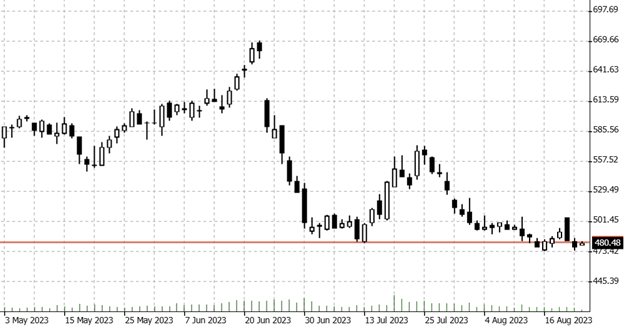

23.08.2023 – Concerns about a corn shortage have vanished into thin air. The price is dipping.
That’s how fast things turn: Just two months or so ago, we had reported on rising prices because of the drought in the United States. But now everything is different. The World Agricultural Supply and Demand Estimates (WASDE) for August gave a mostly bearish picture a few days ago. Here is the daily chart for corn.

Source: Bernstein Bank GmbH
The Agriculture Department initially painted a mixed picture for the U.S. – America is also where the music plays in our trades: “This month’s 2023/24 U.S. corn outlook is for reduced supplies, lower domestic use, smaller exports, and tighter ending stocks.” All in all, the bearish undertone dominated: “Corn production for 2023/24 is forecast at 15.1 billion bushels, down 209 million from the July projection and if realized, would be the second highest on record behind 2016/17.” And it’s this second part of the statement that really packs a punch.
High inventories
Demand in the USA is also falling: “Total U.S. corn use for 2023/24 is cut 95 million bushels to 14.4 billion. Feed and residual use is lowered 25 million bushels based on a smaller crop. Corn used for glucose and dextrose and starch is projected lower based on observed use during 2022/23.” The bottom line is that stock forecasts were only slightly lowered: “ending stocks are lowered 60 million bushels to 2.2 billion. The season-average corn price received by producers is raised 10 cents to $4.90 per bushel.” We think: This extra yield is just a drop in the bucket; it did not support the market.
The verdict of Scott Strand of Hilltop Securities: “For the moment the 2.2 bbu carryout is bearish for US corn prices. We believe that rallies are opportunities for producers to sell, but we don’t see an immediate need for either down and midstream corn users to purchase upside hedges.” In other words, inventories are large enough to keep prices down, there is no reason to hedge long-term with low-priced contracts.
More short positions
In fact, most investors and producers have positioned themselves mostly south. A few days ago, Oliver Sloup of Blue Line Futures judged, “Broken down, funds are holding 255,032 short positions, and 157,527 long positions.” The expert referred to the heat wave in the Midwest. At the same time, however, he stressed the improving outlook for crop quality: U.S. corn was 59 percent “good/excellent,” up 2 percent from a week earlier. In addition, Brazil is likely to have a record crop. For us, this is the most important factor in the whole mix.
Our conclusion: we can hardly see any bullish news for corn. However, the weather can turn things around quickly. Whether long or short – Bernstein Bank wishes successful trades and investments!
________________________________________________________________________________________________________________________________________
The content of this publication is for general information purposes only. In this context, it is neither an individual investment recommendation or advice nor an offer to purchase or sell securities or other financial products. The content in question and all the information contained therein do not in any way replace individual investor- or investment-oriented advice. No reliable forecast or indication for the future is possible with respect to any presentation or information on the present or past performance of the relevant underlying assets. All information and data presented in this publication are based on reliable sources. However, Bernstein Bank does not guarantee that the information and data contained in this publication is up-to-date, correct and complete. Securities traded on the financial markets are subject to price fluctuations. A contract for difference (CFD) is also a financial instrument with leverage effect. Against this backdrop, CFD trading involves a high risk up to the point of total loss and may not be suitable for all investors. Therefore, make sure that you have fully understood all the correlating risks. If necessary, ask for independent advice. CFDs are complex instruments and are associated with the high risk of losing money quickly because of the leverage effect. 68% of retail investor accounts lose money trading CFD with this provider. You should consider whether you understand how CFD work and whether you can afford to take the high risk of losing your money.7
